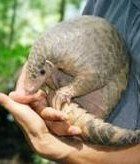Diaries of spirits departed …


 I’ve been reading about a pangolin trafficking operation, described in a recent report by TRAFFIC Southeast Asia1. Sabah Wildlife Department’s raid on a warehouse used by a pangolin trafficking syndicate recovered several logbooks used by the dealers. These books revealed that the criminals meticulously recorded their trafficking activities – being the details of approximately 22,200 pangolins, all of which they’d sourced and trafficked in less than two years. While providing a unique insight into the pangolin trade, this case really exemplifies what levels of organisation can be involved in wildlife trafficking.
I’ve been reading about a pangolin trafficking operation, described in a recent report by TRAFFIC Southeast Asia1. Sabah Wildlife Department’s raid on a warehouse used by a pangolin trafficking syndicate recovered several logbooks used by the dealers. These books revealed that the criminals meticulously recorded their trafficking activities – being the details of approximately 22,200 pangolins, all of which they’d sourced and trafficked in less than two years. While providing a unique insight into the pangolin trade, this case really exemplifies what levels of organisation can be involved in wildlife trafficking.
And the status of pangolins, or scaly anteaters (see examples here) exemplifies the consequences of human encroachment, habitat degradation and destruction, over-hunting and poaching. Pangolins are poached because there are big markets for their body parts. Their characteristic scales are used in traditional medicine, their skins for clothing accessories, their meat for cuisine. There’s a variety of medicinal properties ascribed to pangolin derivatives, including pangolin foetus soup for sexual stamina. Perhaps the pangolin is a victim of not just human vanity and desire, but also of the human imagination.
When I began as an analyst I was started off in vehicle crime investigation. It’s considered a “volume crime” – chances are some of you are car-owners, so perhaps you’ve had a car stereo stolen – or even a whole car. Looking at volume crime is considered a good way to get analytical pups exploring trends, geographical clusters of crime, effects of the surrounding environment on incidence, and so on. Quite a lot of vehicle crime is opportunistic and depends heavily on the protection measures in place in particular locations. You could even call it “subsistence crime” as it involves stealing just enough from a vehicle to cover expenses like a drug habit, or stealing a car for a quick joy ride. Yet there’s also evidence suggesting large-scale, highly organised thefts to order, and a lucrative, transnational trade in stolen vehicles.
So if we’re looking for an example of volume crime in the wildlife trade, pangolins fit the bill. Certainly the pangolin trade is one of the starkest examples of the commodification of wildlife. They’re described as one of the most frequently-seized species in South East Asia. We’ve seen above that their body parts are put to multiple uses, and that there are different drivers for this demand: different industries all demand pangolin corpses. They are seized all over the region, both alive and dead, intact or in pieces, sometimes frozen for transportation purposes. When seizures in excess of twenty tonnes are reported, as in Vietnam in early 2008, then this points to a lucrative, transnational trade of catastrophic proportions.
Poachers report that it’s increasingly difficult to find pangolins, and put this scarcity down to over-hunting. We know what happens next: when the “commodity” becomes rare, the price increases. This pushes up demand by bestowing a luxurious or elusive quality on to the product. Heightened demand drives more poaching, and the population crashes. This kind of scenario is reflected across the wildlife trade. It may help to explain why, by kilo, rhino horn is valued more highly than gold (gold being another natural substance that bewitches and fascinates us humans).
Likewise during the Tiger Campaign investigation to China in 2009, EIA found that tiger skin traders were expecting greater demand – and therefore profits –for tiger skins traded in the Chinese Year of the Tiger. Interestingly, these traders were also aware that there were very few wild tigers remaining – yet didn’t appear to let the “endangered species” factor deter them. Likewise, some pangolin poachers have said they believe that pangolins will become extinct – whilst adding that they can’t stop their activities, because they are too well paid.
I’ve read that the genus name for pangolin, Manis, means a departed spirit or ghost, or a corpse. At the moment, this appears grimly apt.
EIA attended the recent International Tiger Forum in St Petersburg, Russia and heard Chinese Premier Wen Jiabao speak about the fight to save the wild tiger, and advocating the need for a change in human behaviour. If I were to make a New Year’s wish for 2011, it would be for something similar. For a change in human consciousness to value wild over captive, the living over the dead. Some of the potential solutions to illegal trade are familiar. But they appear constrained by equally familiar stumbling blocks, like lack of investment and capacity, corruption, lack of communication, lack of trust. Where else have we encountered these issues? Across the illegal wildlife trade, across continents – even across different forms of crime. Let’s campaign to make these issues the ghosts – instead of pangolins, tigers, forests, and ultimately, ourselves. I hope in 2011, you’ll join EIA for the journey.
Reference 1: Sandrine Pantel and Noorainie Awang Anak (2010). A preliminary assessment of pangolin trade in Sabah. TRAFFIC Southeast Asia, Petaling Jaya, Malaysia
For further information see also: Sandrine Pantel and Chin Sing Yun (ed.) (2009) Proceedings of the Workshop on Trade and Conservation of Pangolins Native to South and Southeast Asia, 30 June-2 July 2008, Singapore Zoo, Singapore. TRAFFIC Southeast Asia, Petaling Jaya, Selangor, Malaysia